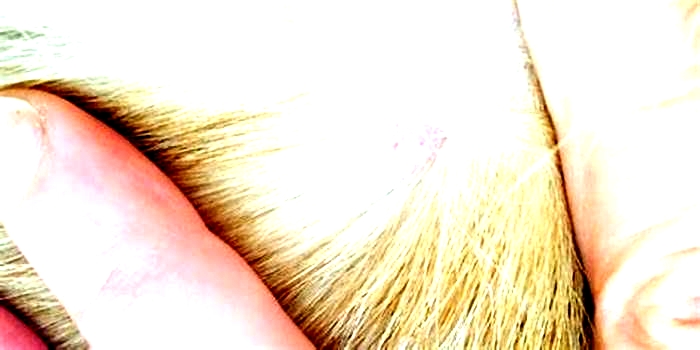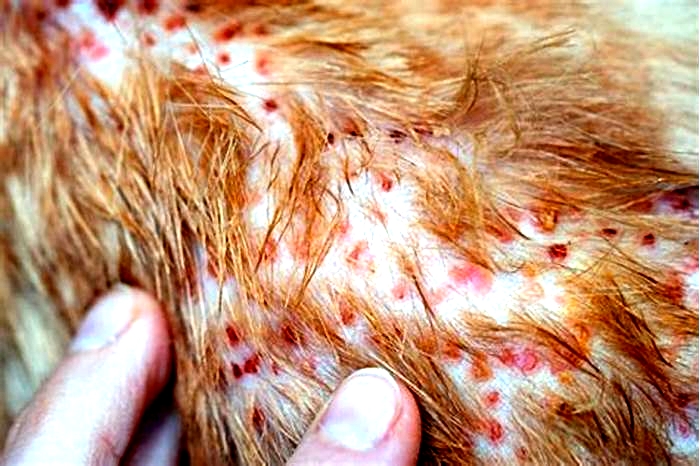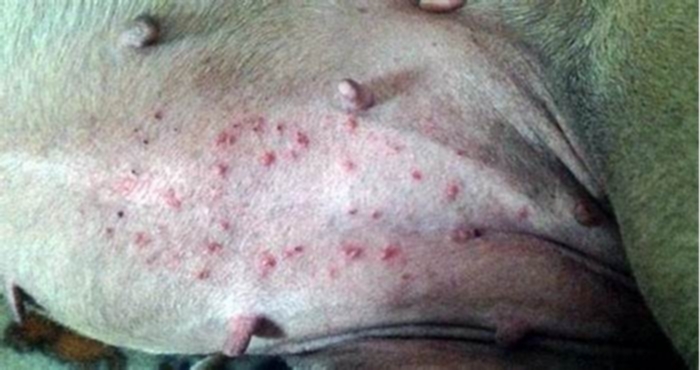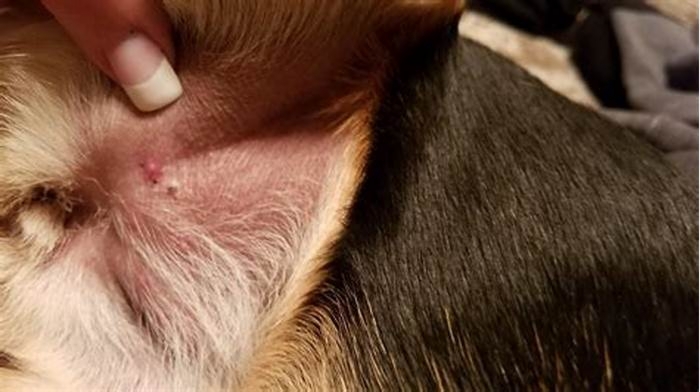Why my dog is getting pimples
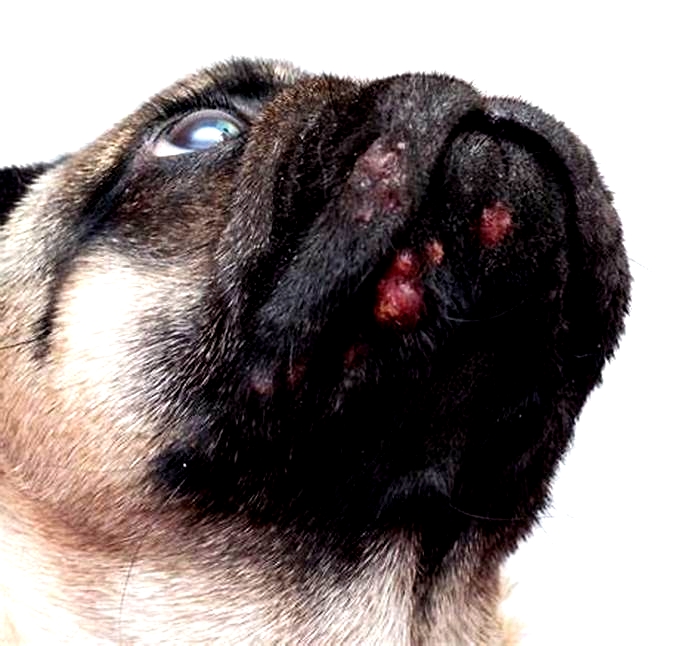
Dog Pimples: An Expert Guide to Acne in Dogs
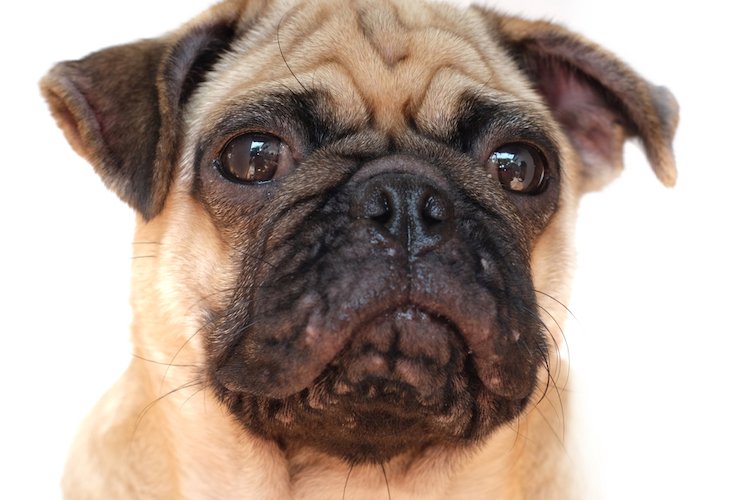
Can dogs get zits?
Yes, they sure can. (And cats can get zits, too.)
Dog pimples, zits, acne, plukes, spots call them what you like, but pimples are definitely a canine thing.
Much like human acne affects teenagers, dog acne tends to affect young dogs. However, unlike in people, the cause of dog acne isnt hormonal but more down to hygiene and genetics.
In this expert guide, well discuss:
- How long do dog pimples last?
- Can I pop a pimple on my dog?
- Whats a good dog acne shampoo?
- Are there dog acne home remedies?
But first, crucial to clearing up dog pimples is understanding why they happen in the first place.
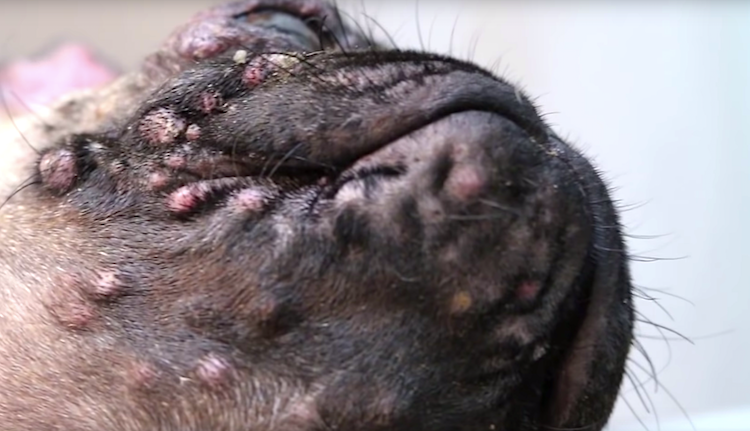
Acne Disorders in Dogs
Its the youngsters who get dog acne.
Think of a bumbling puppy in that oh-so-cute 3- to 12-month age bracket, and these are the guys most likely to get dog pimples.
The most common place for dog acne is on the muzzle and lips. Some dogs also get spots on the belly, but this tends not to be labeled as acne but more as a spotty tummy. (See my article on hyperpigmentation in dogs.)
Oh, and another quirk is that short-coated dogs are more prone to acne the reason for which will soon become clear.
Can Dogs Get Zits?
Yes, and heres why dogs get pimples on their body
What do dogs love to do? They investigate everything with their mouth, thats what.
All that sniffing, chewing, rubbing and biting is hard work for an inquisitive muzzle.
Research now suggests that a playful puppy who is rubbing their chin on a hard surface causes damage to the hairs:
- If these hairs snap off below the skin surface, that sharp bristle causes the hair follicle to inflame.
- With the hair follicle damaged by inflammation, this gives bacteria an open invitation to invade. With lots of bacteria hanging around the broken hair shaft, this is the perfect recipe for dog acne to develop.
- If the spot gets big enough, it ruptures, which leads to a weeping sore. This is also itchy, which leads to a vicious circle of more rubbing, more broken hairs and more dog pimples.
Breed Predisposition to Dog Pimples
Some dogs just have the odds stacked against them because of their breed.
Here are some of the dog breeds predisposed to dog pimples:
These breeds have a genetic predisposition, inherited from their parents, for developing acne.
Its also interesting to note that most of these dogs are short coated. This fits with what we now know about broken hair shafts inflaming the follicles.
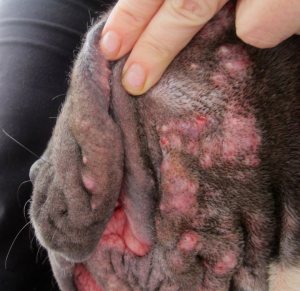
What Does Dog Acne Look Like?
Lets say your dog has bumps on the chin and around the mouth that could very well be acne.
Classic dog acne affects the dogs muzzle, particularly the chin and lips.
Mild acne looks like raised red bumps on the skin. Be sure to look closely: Sometimes the bumps that whiskers grow from, which are perfectly normal, can be mistaken for acne spots.
What Is a Pustule on a Dog?
If those red bumps come to a head, they become whiteheads or the all-too-familiar pimple (more correctly called a pustule). This can be sterile (no bacteria present) or infected (contains bacteria).
Severe acne with lots of dog pimples causes general soreness and swelling. This inflammation makes the skin of the lips and muzzle swell, giving them a fat face.
If the dog then rubs (and who wouldnt?), the zits burst and continued rubbing turns them into bleeding wounds.
Dog acne bleeding requires veterinary attention to prevent scarring, because continued rubbing leads to permanent scar tissue.
Can I Pop a Pimple on My Dog?
No, popping your dogs pimples is not a good idea.
Bursting those zits may be tempting, but its also traumatic to the skin and does more harm than good.
So resist temptation. Instead, try one of the treatment options listed below.
But, it needs to be said, seeing a veterinarian is important. Never assume the problem is simple dog acne, because the problem can be complex.
Skin immunity plays a big part in preventing acne. If the dogs immune system is weak, there may be another more serious condition that needs investigating. The acne then becomes a symptom of a bigger problem, rather than a diagnosis in its own right.
Examples of these predisposing factors include allergy, ringworm or Demodex mites. Either way, a correct diagnosis makes the difference between the treatment working or not.
OK, for those already with a diagnosis of uncomplicated dog pimples, now we will talk about treatments and solutions for dog acne.
Dog Acne Treatments
You cant do anything about the dogs age or breed (both of those things predispose the dog to acne), but you can help their personal hygiene.
Follicle Flushing
Follicle flushing means washing out those dirty hair follicles to keep them sparkling clean. The idea is to remove the bacteria that cause infection and to stop those pimples from developing.
This way, when you resist pimple popping and once the inflammation settles down, theres no evidence the dog ever had a spot.
Follicle flushing is done using medicated shampoo. So whats the best dog acne shampoo?
Look for a dog acne shampoo that contains benzyl peroxide. Yes, this may sound familiar from human acne treatments, but do not use the human version of the shampoo. Its far too strong and burns dog skin, giving a new set of different problems.
You can use a dog acne shampoo in a similar way a teenager uses a facial wash: Wet the dogs skin, work in a bit of shampoo and then rinse well.
Dog Acne and Antibiotics
If the acne is particularly bad or there are bleeding spots, the vet may prescribe antibiotics.
The most common bacteria causing canine acne are theStaphylococcus group, since these are normal residents on the surface of canine skin. Using a good broad-spectrum antibiotic, especially in a dog whos never had antibiotics before, is likely to do the trick.
If the acne keeps flaring up, the vet may then suggest swabbing the skin, to harvest some of the bacteria for culture. This allows for targeted antibiotic usage so the bacteria dont stand a chance.
The antibiotics are usually taken by mouth rather than applied as an ointment. The therapy needs to work from the inside out in order to be effective.
A long course of several weeks may also be needed. Stopping therapy too early can run the risk of a relapse.
Dog Acne and Steroids
If the swelling is particularly bad or the dog just cant stop scratching, the vet may suggest steroids.
This may either be a topical gel, injection or tablets.
The idea is to reduce the swelling and give the dog relief from the discomfort. By reducing the urge to itch, the dog is less likely to damage themselves, which allows things to settle down.
Of course, using steroids in young dogs is not ideal. Which means it makes even more sense to tackle the pimples early when its easier to soothe things away.
How Long Do Dog Pimples Last?
Even with medication, it can take 412 weeks for severe acne to settle down.
But the good news is that individual pimples will be gone in a matter of days or weeks. So if you can keep the skin clean, theres a good chance things will look up soon.
And for those who prefer to try natural remedies, below are some options to try.
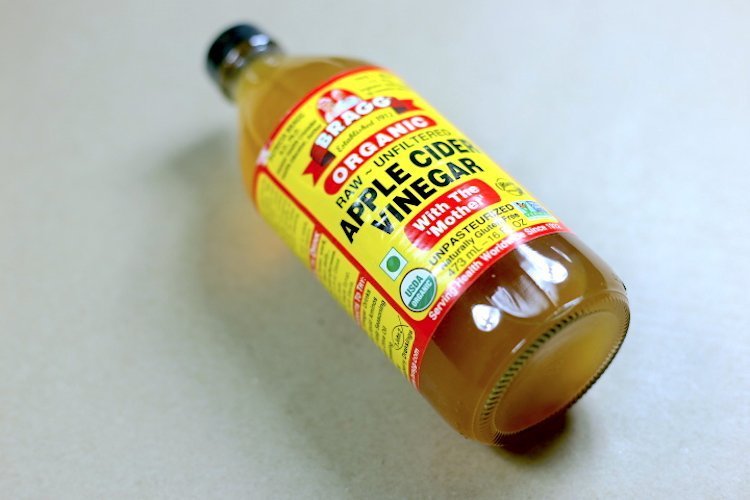
How to Get Rid of Dog Acne the Natural Way
The first option is common sense, and its cleanliness.
If your dog gets a grubby chin from rooting around in dirt, give the dog a bath. This doesnt have to be a full scale shower a clean, moist facecloth around the chops should do the trick.
Do Not Use Coconut Oil for Dog Acne
On the plus side, coconut oil has mild natural antibiotic and antiseptic qualities. Great.
But
On the minus side, this is an oil, so plugging the follicles with a greasy substance could actually feed the bacteria. Given that the antibacterial action is weak, the cons probably out weight the pros. This is why I do not recommend using coconut oil for dog acne.
But dont despair, because there are other natural remedies to try.
Apple Cider Vinegar (ACV)
- Dilute the apple cider vinegar to half strength using warm water.
- Soak some cotton wool with this diluted solution and use it to wipe the dogs chin clean.
This makes the most of ACVs mild antimicrobial and antiseptic properties.
ACV is most effective when used as a preventive measure in acne-prone dogs rather than as a treatment for a full-scale acne flare-up.
Green Tea
Among its beneficial properties, green tea is mildly astringent when applied to the skin. Its also said to have some anti-itch properties, which relieve the dogs need to scratch.
- Make the tea as normal and leave it to cool.
- Then apply topically: Soak some cotton wool in the tea and wipe your dogs chin clean.
Aloe Vera
Known for its antibacterial and soothing properties, aloe vera gel can calm sensitized skin. Apply after bathing the dogs chin.
Aloe vera has the added benefit of hydrating the skin, which may be dried out by washing.
Nettle
Nettle infusion is an old remedy used for alleviating the discomfort caused by conditions such as eczema and acne.
Calendula
This is another traditional remedy to aid skin healing.
- Use a tincture of Calendula, diluting about 6 drops in 1 ounce of water.
- Use this to moisten some cotton wool, and then bathe the dogs chin as before.

Final Thoughts on Dog Pimples
Dog acne has different causes from those leading to human acne.
Good hygiene makes a big difference, but sadly, acne could just be in your dogs genes.
Get a spotty pup checked out by the vet. Fingers crossed its just a matter of using a medicated wash, but sometimes antibiotics are necessary.
But whatever you do, do not start popping your dogs pimples that can lead to scar tissue.
References
- Barnette, Catherine, DVM. Acne in Dogs. VCA Hospitals. 2017. https://vcahospitals.com/know-your-pet/acne-in-dogs.
- Spiegel, Ian B., VMD, MHS, DACVD. Just Ask the Expert: How Do You Manage Canine Chin Acne? dvm360. Feb. 1, 2011. http://veterinarymedicine.dvm360.com/just-ask-expert-how-do-you-manage-canine-chin-acne.
- Moriello, Karen A., DVM, DACVD. Overview of Pyoderma. Merck Veterinary Manual. https://www.msdvetmanual.com/integumentary-system/pyoderma/overview-of-pyoderma.

This pet health content was written by a veterinarian,
Dr. Pippa Elliott, BVMS, MRCVS. It was last reviewed April 5, 2022.
If you have questions or concerns, call your vet, who is best equipped to ensure the health and well-being of your pet. This article is for informational purposes only and is not a substitute for professional medical advice, diagnosis or treatment. See
additional information.
Can Dogs Get Pimples? Causes, Treatment & When to Bring to Vet
You share many things with your dog. Ever wonder whether you share too much?
You share your time, your snacks ( can dogs eat pineapple?), and your snuggles. But can you share the flu with your dog? Or viruses?
What about pimples? Does your dog share the same annoying skin issues we humans deal with too? While sharing diseases with your dog is possible, its very rare.
However, dogs can, and do, develop pimples. And theyre sort of the same kind we deal with.
But dont start sharing beauty secrets, pimple remedies, and zit-creams with your BFFbecause lets face it, someone has done it. Instead, read on to find out why dogs get pimples in the first place, what they look like, and why human acne products are not meant for sharing.
Do Dogs Really Get Pimples?
 Yes, dogs can actually get pimples. They can be mild or serious.
Yes, dogs can actually get pimples. They can be mild or serious.
Dog pimples, or canine acne, is an inflammatory disorder resulting in pimples appearing mainly on the lips and on the skin of the muzzle.
Dogs can develop different types of pimples including:
- Pustules
- Papules
- Comedones
Pustules
Small bumps on the skin filled with pus. Usually caused by infection, most commonly staphylococcus, or pyoderma. Pyoderma, sometimes called impetigo, is an infection caused by bacteria. Pyoderma is most commonly seen in puppies.
Papules
Small red, scaly bumps caused by inflamed skin cells. A flea allergy is a common culprit resulting in papules.
Comedones
A comedo is another name for an acne lesion. It forms when a pore, or hair follicle, becomes clogged with debris. More commonly called acne such as whiteheads and blackheads.
Dog acne can range from mild cases of small, red, non-infected pimples on the skin. Or dog acne can be more serious. Severe dog acne is known as generalized acne. When dogs have serious cases of acne you might notice symptoms that include:
- Bleeding
- Scabs
- Swelling around the lips
- Swelling around the muzzle
- Pus
Furthermore, some breeds are more vulnerable to acne breakouts than other breeds. Pimple-prone pooches include:
- Boxers
- English Bulldogs
- Great Danes
- Hairless breeds
- German Short-Haired
- Rottweilers
Whitehead Dog Pimples
Whiteheads are common human acne. Whiteheads are clogged pores, also referred to as closed comedones because the clogs are enclosed by a layer of skin. Whiteheads in humans are essentially pimples that form a white head, essentially the contents of the pimple.
Dogs can get small bumps on their skin that may at first look like whiteheads common to human acne. But what may appear to be several whitehead dog pimples, might actually be sebaceous cysts. Sebaceous cysts are very common in dogs.
Usually, sebaceous cysts arent problematic unless they begin to break open. At that point, theyre also open to potential infections and bacteria getting in it.
Sometimes, sebaceous cyst treatment is necessary and usually, surgery is most effective to get rid of it for good. But, removal isnt always necessary. As they are very slow-growing and can take a long time to reach the point of potential infection. Still, it may be wise to get it checked out by a vet first and then monitor it for any changes.
Why Does My Dog Have Pimples?
 Dog acne can form for a variety of reasons and may or may not involve infection. Acne is a physical change in skin tissue, usually caused by:
Dog acne can form for a variety of reasons and may or may not involve infection. Acne is a physical change in skin tissue, usually caused by:
- Physical injury to the skin
- Disease
The hair follicles inside pores can become irritated quite easily, for instance, when a dog rubs its face on a scratchy surface to get an itch. Microscopic tears in the skin can result after a dog scratches its face using its claws, much like when humans use abrasive skin exfoliates. When there are tears in the skin, the hair follicle can become inflamed, bacteria or debris can enter the skin, and potentially clog pores that lead to dog acne.
Clogged pores are:
- Dead skin cells
- Keratin (a protein found in hair, skin, and nails)
- Sebum (oil)
Essentially, anything that disrupts the skins normal process of moving oil and protein through layers of the skin as per usual, can cause dog acne to form.
Often, pimples go away on their own. But they can also swell and become infected. Pimples that pop, break, or otherwise become enlarged due to the clog are more likely to become infected because bacteria have a way to get in it. While canine acne is considered an inflammatory disorder, dog acne is non-infected. That is, until it becomes infected.
Note that some pimple-like bumps are caused by bacteria, and therefore, are infected. While those bumps may look like acne, their underlying condition is different.
Dog acne can be caused by various factors or underlying conditions. While the causes of dog acne arent entirely clear, experts can agree on several things:
- Dog acne is an inflammatory disorder
- Other bumps may resemble dog acne
- Dog acne mostly appears on the dogs lips and muzzle
- Dog acne inflammation is initially non-infected
Other bumpy skin conditions would need to be ruled out by a veterinarian.
Experts can also agree about several possible reasons why dogs develop acne. While some reasons are less common than others, they include:
- Hormones
- Skin trauma
- Allergies
- Parasites
- Infection
- Genetics
Skin Trauma
This is the most common cause of dog acne. Skin trauma can happen for a number of reasons. When dogs play rough, scratch, or use their muzzle to explore everything in their environment, they increase their risk of damaging the outermost layer of skin and causing inflammation to pores and hair follicles.
Allergies
Dog acne can pop up due to allergies. A dog may rub its face on surfaces to relieve itchiness which can cause the area to become irritated, making it easier for debris, irritants, and bacteria to enter the pores. Types of allergies that can lead to dog acne or breaking out in an acne-like rash are
- Contact
- Environmental
- Food
Like dog flu food allergies are not common in dogs, as only 5% of cases are allergy-related. But when they occur, dogs may experience a host of symptoms that look like dog acne including
- Swelling
- Redness
- Red bumps (hives)
Parasites
Fleas and mites can make dogs itch to the point of breaking the skin and irritating hair follicles leading to dog acne. Moreover, fleas and mites can cause small, red bumps that resemble dog acne.
Oily Skin
Hormone disrupting disorders like Cushings disease or other thyroid-disrupting issues can create hormonal imbalances. Hormonal dysregulation can lead to the skin overproducing oil. Excessive oil production can clog pores resulting in dog acne when it mixes with other pore-clogging debris like dead skin cells and keratin.
Infection
Infections can also lead to dog acne, or acne-like lesions, on a dogs skin. Dog pimple culprits may be:
- Viral
- Fungal
- Bacterial
Bacteria
The most common acne-causing bacteria found in dogs is called Staphylococcus. Bacteria can find their way into pores through inflamed follicles, or through micro-tears on the skin. Pores that are already clogged, in the case of blackheads and whiteheads, for example, can become infected when bacteria enter the pore and become stuck among the clogged debris.
Folliculitis
When short hairs are pushed underneath the skins surface, a condition known as folliculitis can occur. The impacted follicle becomes inflamed and the formation of small bumps that resemble acne can form. But unlike dog acne lesions that may be inflamed but not infected, folliculitis is caused by an infected hair follicle, most commonly due to bacteria.
So, while dog acne and folliculitis may look similar their causes are different. Also, dog acne is usually found on a dogs lips and muzzle. On the other hand, folliculitis can appear anywhere.
Other infections or diseases that can lead to folliculitis:
- Parasites
- systemic disease
- Immune system disorders
- Trauma
- Endocrine problems
Understanding the difference between dog acne (blocked pore) and folliculitis (infected hair follicle) is important for getting dogs the right treatment.
Genetics
Certain breeds are more vulnerable to developing dog acne due to their genes. Short-haired breeds are particularly susceptible because their skin is more exposed, like hairless breeds for instance. Also, short-haired breeds often have coarse fur closer to the skins surface, making it easier for it to become impacted.
Other conditions that can resemble dog acne but may be more serious or contagious, include
- Demodicosis: a type of mange (mites) transmitted from mother to puppy that may resemble whiteheads.
- Ringworm: a type of fungus that resembles acne in its early stages and can be spread from dogs to humans.
- Puppy Strangles: a potentially fatal non-contagious skin condition resembling acne-like blisters and scabs, diagnosed in puppies and young dogs.
Where Canine Acne Can Appear
 Dog Acne is most commonly found around the mouth area, specifically, the chin, lips, and muzzle. A pimple may form as an individual comedo or may appear in clusters. If dog acne becomes infected, the vet may test for the type of bacteria, virus, or parasite causing the infection. Doing so will tell you what type of treatment is needed.
Dog Acne is most commonly found around the mouth area, specifically, the chin, lips, and muzzle. A pimple may form as an individual comedo or may appear in clusters. If dog acne becomes infected, the vet may test for the type of bacteria, virus, or parasite causing the infection. Doing so will tell you what type of treatment is needed.
Dog Acne on Chin
The chin is one of the most common areas for dogs to develop acne. There are several reasons for this.
Muzzle Folliculitis
This is caused when short, coarse hair commonly found on a dogs chin is easily impacted which can cause inflammation and lead to acne.
Muzzle Furunculosis
When the broken or impacted hair causes injury to the hair follicle below the surface of the skin, it can lead to inflammation and infection. Often the infected hair follicle contains pus. When a hair follicle becomes impacted and inflamed, bacteria can find a way in resulting in infected acne lesions.
Dog Pimple on Lip
The lips are a common area for dog acne to form as well. There are several causes for pimples that form on a dogs lips.
Mouth Bacteria
So, are dogs mouths cleaner than humans? Poor dental hygiene is unfortunately common in dogs. Dogs frequently suffer from gum disease, cavities, and oral bacteria. When a dog doesnt receive proper dental care via regular visits to the dentist or daily teeth cleaning, bad bacteria move in. If left untreated, its possible for bacteria to find their way to a dogs lips and mouth and cause dog acne.
Oral Papillomas
Papillomas are warts caused by a virus and are spreadable between dogs. They may look like big pimples located around the mouth and lips. Mostly common among puppies, oral papillomas may not require treatment because they normally go away on their own and typically arent harmful.
Infected Dog Acne
Dog acne can become infected when bacteria enter the clogged pore and get trapped. Infected dog acne results from debris and oil blocking the opening of a hair follicle. An infected dog pimple is called a pustule and is filled with pus and bacteria.
Symptoms of infected dog acne may present with symptoms like
- Swelling
- Redness
- Whiteheads
- Pus
- Bleeding
- Scabbing
Dog Pimples on Back
A pimple on a dogs back can resemble acne but may actually be a sebaceous cyst. A sebaceous cyst is a clogged oil gland that is often much larger than a typical acne pimple. Sebaceous cysts can form when a dogs body is producing too much sebum and causes its pores to become clogged with excess oil. Usually, the cysts arent harmful and treatment may not be needed.
Dog Pimples on Belly
A condition called pyoderma can cause a pimple-like rash to form on a dogs underside. The rash may look a lot like dog acne. Pyoderma may be caused by yeast, bacteria, or fungus and presents with symptoms such as
- Pustules
- Red bumps
- Redness
- Swelling
- Crusty skin
Pimple on Dog Eyelid
A stye on a dogs eyelid can look like a pimple. A stye, also known as a hordeolum, forms on the eyelid and may cause temporary swelling. The culprit that causes a stye to form is a bacteria of the oil gland called Staphylococcus aureus. The swelling is due to the pus inside, but unless the dog scratches the area and causes it to burst, a stye will usually heal on its own.
Pimple on Dog Paw
Dogs can develop a pimple-like abscess on their paw, commonly developing on the webbing between the dogs toes. The lesion is similar to a large, pus-filled pimple and is known as interdigital furuncles. Its similar to folliculitis that can develop on a dogs chin. The primary cause is hair follicles impacting the surrounding skin, causing inflammation. Bacterial infection is then common due to the pore becoming enlarged.
Dog Ear Pimple
Usually, sebaceous cysts can form on a dogs ear and be mistaken for dog acne. Sebaceous cysts may appear anywhere on a dogs body, any size, and may resemble a whitehead. Additionally, small bumps on the outer ear may be due to mites or other parasites that burrow under the surface of the skin, causing bumps to form.
Dog Whisker Pimple
Whiskers are essentially fur follicles except much deeper. And like the rest of a dogs follicles, whisker follicles are susceptible to folliculitis and infection. A dog can develop a pimple on its muzzle that starts as an ingrown whisker.
Find the table below for a quick dog pimple reference guide.
| Dog Pimple Location | Possible Explanation |
| Chin | Muzzle folliculitis or Muzzle furunculosis |
| Lips | Acne lesions or small warts known as oral papillomas |
| Back | A sebaceous cyst |
| Belly | Pyoderma, an infection caused by yeast, bacteria, or fungus. |
| Eyelid | A hordeolum, or stye, caused by bacteria. |
| Paw | Interdigital furuncles, a pus-filled lesion caused by bacteria. |
| Ear | Tiny mites or another parasite that burrows beneath the skins surface. |
| Whiskers | An infected ingrown whisker or folliculitis that has formed a pimple. |
Dog Acne Treatment

 Treatment #1 Anti-Inflammatory
Treatment #1 Anti-Inflammatory
Veterinarians may use an anti-inflammatory to treat dog acne. The most common anti-inflammatory medications include
- Oral steroids
- Topical steroids
Treatment #2 Antibiotics
Antibiotics can be used to treat dog acne when a bacterial infection is present. Antibiotics reduce the number of bacteria that are present on the surface of the skin and within acne lesions. A veterinarian may prescribe
- Topical antibiotics
- Oral antibiotics
Treatment #3 Antifungal
Pyoderma causes lesions on a dogs skin that look a lot like acne. Pyoderma bumps look like small, red bumps on the skin and may be caused by bacteria or fungus. When the condition is caused by a fungus, your veterinarian may prescribe treatment, like
- Antifungal shampoo
- Topical antifungal medication
- Oral antifungal medication
- Oral antibiotics
Dog Acne Home Remedies
 If you feel that your pups particular case of dog zits doesnt warrant a trip to the vet then you might want to know how to treat dog acne at home. There are some at-home dog acne remedies you can try.
If you feel that your pups particular case of dog zits doesnt warrant a trip to the vet then you might want to know how to treat dog acne at home. There are some at-home dog acne remedies you can try.
Hydrogen Peroxide for Dog Acne
Avoid using hydrogen peroxide to treat dog acne. Because dog acne may be considered open wounds, hydrogen peroxide may be harmful to a dogs skin and cause further irritation. Hydrogen peroxide is toxic to dogs and can make them vomit if ingested, even in less-concentrated solutions.
Benzoyl Peroxide for Dog Acne
Benzoyl Peroxide seems to be one of the most common and effective at-home dog acne treatments. Shampoo or face wash containing benzoyl peroxide can effectively clean a dogs pores by removing excess oil and debris. A topical benzoyl peroxide application such as a medicated shampoo or gel may be used once a week to treat dog acne at home.
Use Hypoallergenic Wipes
You can help manage dog acne by keeping their face clean. This is especially important if your particular breed has lots of folds and wrinkles where dirt and bacteria can hide. You can use hypoallergenic wipes daily to help keep your dogs face clean and control dog acne from spreading.
Check out the following table showing how to get rid of dog acne and what to avoid.
| Professional | At-Home | Avoid |
| Anti-inflammatory: Oral or topical steroids like Prednisone or prednisolone. | Benzoyl Peroxide: It seems to be the most common and effective at-home treatment. | Coconut Oil: Coconut oil is comedogenic meaning it clogs pores and may lead to more acne. |
| Anti-fungal: Oral or topical medications like chlorhexidine or ketoconazole. | Hypoallergenic face wipes: Helps to stop the spread of acne and bacteria, especially in wrinkly dogs. | Aloe Vera and Apple Cider Vinegar: While aloe vera may soothe a painful acne lesion, it does not treat dog acne. Apple cider vinegar may irritate open dog acne lesions. |
| Antibiotics: Topical or oral medications may be prescribed, like mupirocin to decrease bacteria count or oral antibiotics for infected cases. Oral antibiotics are usually given for 4-8 weeks. | Daily oral hygiene regimen: Brushing the dogs teeth to keep bacteria from spreading to the lips and chin is helpful for preventing dog acne. | Hydrogen Peroxide: Toxic to dogs if ingested even in small amounts and may cause further irritation to a dogs skin. |
Tips on Preventing Dog Acne
 Dog acne might be inevitable but thankfully not as serious as pneumonia in dogs or kennel cough. Still, there are ways to help your dog from developing more, or more serious, acne. Just follow a few tips.
Dog acne might be inevitable but thankfully not as serious as pneumonia in dogs or kennel cough. Still, there are ways to help your dog from developing more, or more serious, acne. Just follow a few tips.
Resist Popping Dog Acne
Prevention is so easy if only resisting temptation were easy too. While not everyone has made pimple-popping a hobby, some folks just find it fascinating. Nobody can stop you from popping the pimples on your face. But do the dog a favor and resist the urge to pop theirs. Popping your dogs pimples can cause pain, inflammation, and more acne. And nobody wants that.
Oral Hygiene for Dog Acne on Chin
Have you brushed your dogs teeth today? If you havent gotten into the habit yet you might be surprised how much brushing can benefit your dogs oral health. It may prevent acne from forming around the mouth too.
Clean Dog Bowls and Toys
Occasionally cleaning the things your dog puts in its mouth can keep dog acne away. While you cant prevent everything from getting into your dogs mouth, you can do your part in making sure their food bowls and squeaky toys are free from harmful bacteria. Considering bacteria can live longest on surfaces made of plastic or stainless steel, occasionally cleaning dog bowls and chew toys is a good idea.
Acne-causing bacteria is bad enough, now how long does kennel couch live on surfaces?
FAQ

 How to Get Rid of Dog Acne?
How to Get Rid of Dog Acne?
Topical remedies are best. Shampoo, face wash, or topical gels containing benzoyl peroxide are most effective for treating dog acne. Avoid using human acne products on dogs as the active ingredients they contain are too harsh and may be harmful.
What Does Dog Acne Look Like?
Most common on a dogs chin, lips, and muzzle, dog acne usually looks like red or white bumps. Dog zits may be big or small. They may resemble common pimples like whiteheads and contain pus if infected.
Can I Treat Dog Pimples Naturally?
While some claim coconut oil, aloe vera, and apple cider vinegar are effective for treating dog acne, its best to steer clear without first talking to a vet. Coconut oil can clog pores and make acne worse. Aloe vera might be toxic to dogs if ingested and will not clear-up dog acne.
However, it may be used as a topical solution to relieve painful acne spots. Apple cider vinegar, when diluted, may be used to treat acne spots but shouldnt be used on open wounds so its best avoided on broken dog acne.
Conclusion
Even though dog acne is caused by benign material like dead skin cells and excess oil, pores may be more vulnerable to harmful material like bacteria. When this happens, dog acne can become infected. So, while dog acne isnt necessarily serious, it can become a bigger issue if it isnt treated or managed. Use this guide to help you, as some conditions only resemble acne, so its always best to get any strange lump or bump also checked out by a vet.

